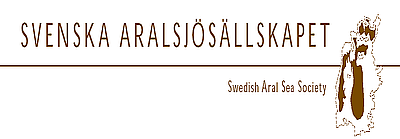2a.
Energy supply and use

Chicago by night. CC BY-NC-ND 2.0 Photo: Lionel Tinchant.
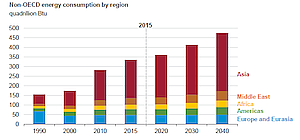 Energy is fundamental in our lives. Development and energy consumption in a society is typically parallel up to a point when energy use is levelling off, but then the energy consumption is already large. In Europe, it is close to 100 times our personal metabolic energy from the food, that is, the base for keeping alive. This is about 2.4 kWh/day, corresponding to an effect of 100 W. Still energy use differs much between countries and individuals, and also depends on methods for measuring it. Sweden uses each year about 400 TWh for 10 million inhabitants, industries and all kinds of societal needs.
Energy is fundamental in our lives. Development and energy consumption in a society is typically parallel up to a point when energy use is levelling off, but then the energy consumption is already large. In Europe, it is close to 100 times our personal metabolic energy from the food, that is, the base for keeping alive. This is about 2.4 kWh/day, corresponding to an effect of 100 W. Still energy use differs much between countries and individuals, and also depends on methods for measuring it. Sweden uses each year about 400 TWh for 10 million inhabitants, industries and all kinds of societal needs.
When discussing energy, it is useful to be acquainted with a few fundamentals. Energy is constant in the sense that it is not produced or consumed; it is only transformed from one kind to another, more or less useful for a purpose. Thus, a power station transforms energy stored in e.g. fossil carbon, or biomass, or high-level water, into electricity in a generator run by a turbine. The energy produced during a set time period is the effect of the power station. The usefulness of the energy – its capacity to do work – is called exergy. Electricity has 100% exergy, while the exergy of hot water or gas depends on its temperature: higher temperature means higher exergy.
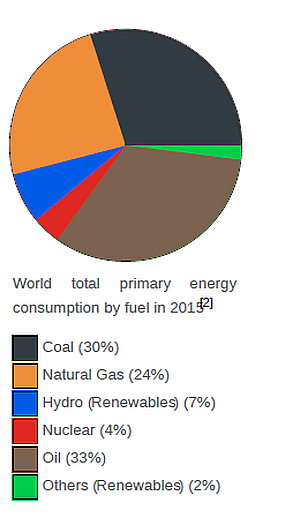 Energy can be stored as in fossil carbon or biomass, or flowing like in flowing water or in wind (flowing air) or the sun (flowing light). Stored energy functions as a fuel, while flowing energy is intermittent, it needs to be used directly. The transformation of intermittent energy into stored is a key difficulty for energy management. Hydropower has a unique capacity here as it can be stored as water in a dam on higher level. We will discuss energy in three forms: electricity (the best) heat (mostly hot water) and stored fuel. All of them can be quantified as Wh (Watt hours, other measures are also used) mostly expressed as kWh, MWh, GWh or TWh, using the prefixes, kilo, Mega, Giga or Tera for a thousand, a million, a billion and trillions.
Energy can be stored as in fossil carbon or biomass, or flowing like in flowing water or in wind (flowing air) or the sun (flowing light). Stored energy functions as a fuel, while flowing energy is intermittent, it needs to be used directly. The transformation of intermittent energy into stored is a key difficulty for energy management. Hydropower has a unique capacity here as it can be stored as water in a dam on higher level. We will discuss energy in three forms: electricity (the best) heat (mostly hot water) and stored fuel. All of them can be quantified as Wh (Watt hours, other measures are also used) mostly expressed as kWh, MWh, GWh or TWh, using the prefixes, kilo, Mega, Giga or Tera for a thousand, a million, a billion and trillions.
Today 85% of the global energy supply consists of fossil carbon: coal, oil and gas. This is not surprising considering that coal and oil has the highest concentration of energy we can imagine. Black coal has been used even from medieval times. The access to large amounts of oil from the 1860s and on led to rapid industrialization, urbanization and economic growth (Session 10a). The amounts of oil produced worldwide have increased ever since, especially with the discoveries of large oil fields in the Middle East. Oil is so good that the world has turned into oil addicts. It is thus a shock for countries that have relied on these sources of energy since even hundred of years to learn that they cannot continue burning fossil carbon as it leads to emissions of carbon dioxide, which cause climate change.
Coal, oil and gas are non-renewable resources and their use is unsustainable (See further Session 3a). This means that at some point in time its production will peak and then decline. This is called peak oil. It is much studied but difficult to predict as much data are hidden. For specific countries and fields it is, however, well known. Thus, US peak oil occurred in 1970 and the Norwegian peak oil was 1996-1999. Global peak oil occurs about now. Discovered oil fields have been declining since the 1960s. Of course the price of coal, oil and gas will increase when less is produced after the peak. Conventional oil will then be substituted for by unconventional, e.g. extracted from tar sand, or pumped from deep water, which will be more expensive, both in terms of energy to produce it and costs for producing it. Conventional oil peaked already about 2005.
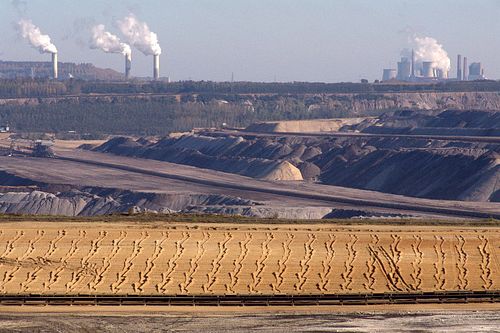
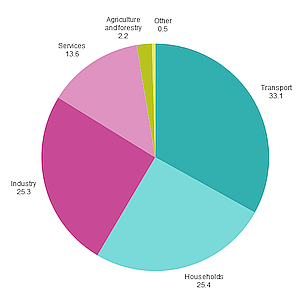 In most countries electricity are provided from power plants, most often using coal, lignite or natural gas as fuel. The fuel is incinerated to heat water, which is sent to a turbine which runs a generator producing electricity. This is not sustainable as it depends on fossil fuels. Power plants may be improved in two ways. By using the hot water from the turbines for district heating the plant (now CHP, Combined Heat and Power) increases the efficiency from about 39% to about 90%. Exchanging the fossil fuel for peat is an improvement, as is household waste, but best is to use biomass such as wood from energy forests or wood waste (roots, branches etc) to turn the power plant into a producer of renewable energy.
In most countries electricity are provided from power plants, most often using coal, lignite or natural gas as fuel. The fuel is incinerated to heat water, which is sent to a turbine which runs a generator producing electricity. This is not sustainable as it depends on fossil fuels. Power plants may be improved in two ways. By using the hot water from the turbines for district heating the plant (now CHP, Combined Heat and Power) increases the efficiency from about 39% to about 90%. Exchanging the fossil fuel for peat is an improvement, as is household waste, but best is to use biomass such as wood from energy forests or wood waste (roots, branches etc) to turn the power plant into a producer of renewable energy.
Nuclear power (NP) is not renewable for the simple reason that uranium is a fossil resource. Even if nuclear power plants can be safer and more efficient (3rd generation technology) than earlier, we are left with the problem of the nuclear waste, which remains toxic and radioactive for many thousands of years. It also appears that NP is too expensive for commercial investments and can only be built with governmental support. Very few NP plants are built today, although many are being planned. However, they do not emit carbon dioxide, which contributes to global warming, why many concerned scientists promote NP.
To become a sustainable society we need to change our energy regime completely and rely on renewable resources. Renewable energy resources all ultimately come from the sun. The sun makes the water move, the wind blow and the trees and plants grow. In one-way or the other a sustainable society needs to find out how to use the sun well and cleverly. And there is enough for all of us. Humankind uses about 0.1 per mille of the energy content of the sun coming to us every day and minute. Just as the ecosystems found in Nature depend on the sun for its survival, human society needs to do the same thing. To replace the large scale dependency on fossil fuels to renewable energy schemes is perhaps the most difficult part of a transition to sustainable societies.
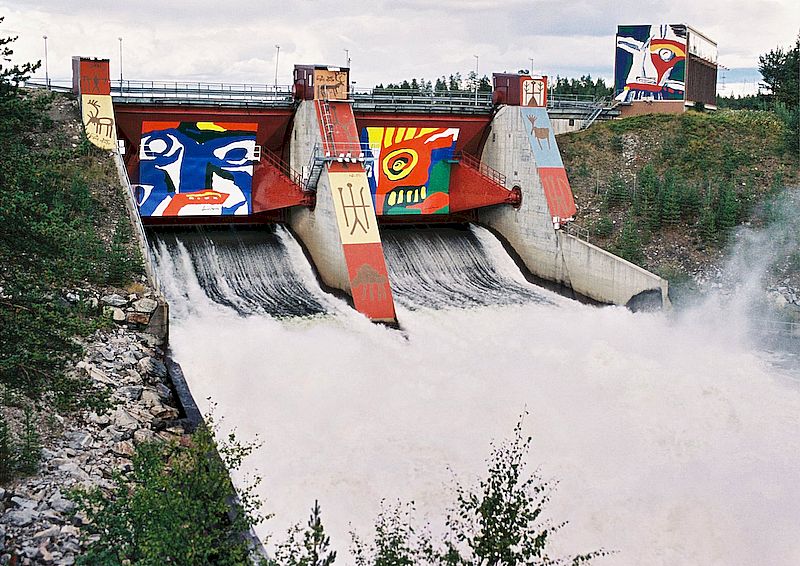 Akkats hydroelectric power plant in Swedish Lapland. Photo: Hans Blomberg
Akkats hydroelectric power plant in Swedish Lapland. Photo: Hans Blomberg
Renewable electricity is produced from hydropower plants, from wind power stations, and directly from solar cells, either photovoltaic, which directly transfers sunlight into an electric current, or from CSP, Concentrated Solar Power, in which the heat of the sun is focused to produce hot liquid producing electricity in a turbine. In the BSR hydropower is providing almost all of Norway’s electricity and 50 % of Sweden’s electricity, and a fair share in some of the other countries. Wind power is very important in Denmark (about 40% of electricity) and Germany. Solar cells are not big anywhere but increasing fast, by some 40% yearly. Other technologies include small hydropower plants, wave power at the coasts, electricity from running water, and electricity from power stations using renewable fuels such as biomass.
Renewable heat is important in many parts of the Baltic Sea region to heat our houses. Heating houses are mostly done using combustion. It may be in Eastern Europe most typically natural gas, but in the Nordic countries the earlier oil has been almost completely changed into biomass as wood: wood chips, or wood pellets, all renewable biomass. In district heating the houses in urban areas are connected to one common power plant. This is very much more efficient than a series of individual boilers, not the least because flue gases may be purified much more efficiently. Household waste incineration, the waste to energy step in waste management, takes care of waste and avoids landfill. This is seldom fossil fuel free as there is much plastic in household waste. It also requires good flue gas cleaning. Solar panels on the roof or larger size (municipal) may be used for solar heat. This is standard in Southern Europe. In the Baltic Sea region solar panels may heat houses and at best provide all hot water during March to October. Heat pumps use electricity to extract heat from ground or outdoor air. This is up to 4-5 times more efficient than direct electric heating and is renewable if the electricity is. Heat pumps are important in Sweden.
Renewable fuel is mostly biomass either as solid (wood), liquid or gas. This is most critical for road traffic, which today is almost entirely oil dependent. Bio-ethanol from fermentation of sugar, e.g. sugar beet (1st generation bio-ethanol), or cellulose after hydrolysis (2nd generation bio-ethanol) is renewable if produced in such a way. Today all petrol in the EU contains 5% ethanol; it may be increased to 10% without technical problems. Some cars and buses use E85 with 85% ethanol. Biodiesel is produced from oil crops, such as rapeseed, after extraction and methylation. It can easily replace standard diesel e.g. in buses and trucks. Production of biogas from anaerobic fermentation of organic waste (households, farms, wetlands etc) is increasing rapidly. In the Nordic countries it is mostly used for city buses. Biogas buses are more silent, less polluting and more sustainable. However transport is best done using electricity as it is about 4-5 times more efficient, less polluting, more silent and cheaper. The problem is the insufficient capacity of today’s batteries.
Materials for session 2a
Basic level
- Read A Sustainable Baltic Region, session 2, pages 5-10: Energy Use – For What?.
- Read Energy Production in the Rural Landscape In: Rural Development and Land Use.
- EU Energy Statistics 2017 edition see also EU Energy in Figures 2022.
- Read A Sustainable Baltic Region, session 2, pages 25-32: Environmental Effects of Energy Use in the Baltic Region.
- Climate Change Science and Impacts Factsheet, Center for Sustainable Systems, University of Michigan.
Medium level (widening)
- Read A Sustainable Baltic Region, session 2, pages 11-16: The Global context.
- Nordic Energy Solutions – A collection of projects on renewable energy in the Nordic countries, mostly by energy companies
- The European Commission Site on Energy contains information on all EU countries, the European energy strategy and a wealth of basic data.
Advanced level (deepening)
- Study in some detail one large commercial energy project:
Solar electricity from the Sahara Desertec
Gas pipeline in the Baltic Sea Nordstream
Lysekilsprojektet and wave power on the Swedish West coast - Read Environmental Management, book 2, chapter 6, pp 97-104: Energy Conservation
Additional materials
Livelihoods and climate change (addresses mostly the global south) from International institute of Sustainable Development (IISD).
References
Karlsson, I. and L. Rydén (eds.). 2012. Rural Development and Land Use. Ecosystem Health and Sustainable Agriculture: Book 3, Baltic University Press, Uppsala.
Nilsson, L., Persson, P. O., Rydén, L., Darozhka, S. and A. Zaliauskiene. 2007. Cleaner Production - Technologies and Tools for Resource Efficient Production Environmental Management Book 2, Baltic University Press, Uppsala.
Salay, J. (ed.) 1997. Energy – from fossil fuels to sustainable energy resources. In: A Sustainable Baltic Region, Session 2. Baltic University Press, Uppsala.
BUP Sustainable Development Course
